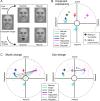Perceived emotional expressions of composite faces
- PMID: 32155204
- PMCID: PMC7064203
- DOI: 10.1371/journal.pone.0230039
Perceived emotional expressions of composite faces
Abstract
The eye and mouth regions serve as the primary sources of facial information regarding an individual's emotional state. The aim of this study was to provide a comprehensive assessment of the relative importance of those two information sources in the identification of different emotions. The stimuli were composite facial images, in which different expressions (Neutral, Anger, Disgust, Fear, Happiness, Contempt, and Surprise) were presented in the eyes and the mouth. Participants (21 women, 11 men, mean age 25 years) rated the expressions of 7 congruent and 42 incongruent composite faces by clicking on a point within the valence-arousal emotion space. Eye movements were also monitored. With most incongruent composite images, the perceived emotion corresponded to the expression of either the eye region or the mouth region or an average of those. The happy expression was different. Happy eyes often shifted the perceived emotion towards a slightly negative point in the valence-arousal space, not towards the location associated with a congruent happy expression. The eye-tracking data revealed significant effects of congruency, expressions and interaction on total dwell time. Our data indicate that whether a face that combines features from two emotional expressions leads to a percept based on only one of the expressions (categorical perception) or integration of the two expressions (dimensional perception), or something altogether different, strongly depends upon the expressions involved.
Conflict of interest statement
The authors have declared that no competing interests exist.
Figures



Similar articles
-
Effects of affective and emotional congruency on facial expression processing under different task demands.Acta Psychol (Amst). 2018 Jun;187:66-76. doi: 10.1016/j.actpsy.2018.04.013. Epub 2018 May 8. Acta Psychol (Amst). 2018. PMID: 29751931
-
Effects of Briefly Presented Masked Emotional Facial Expressions on Gaze Behavior: An Eye-Tracking Study.Psychol Rep. 2019 Aug;122(4):1432-1448. doi: 10.1177/0033294118789041. Epub 2018 Jul 22. Psychol Rep. 2019. PMID: 30032717
-
Happy mouth and sad eyes: scanning emotional facial expressions.Emotion. 2011 Aug;11(4):860-865. doi: 10.1037/a0022758. Emotion. 2011. PMID: 21859204
-
Categorical Perception of Fear and Anger Expressions in Whole, Masked and Composite Faces.PLoS One. 2015 Aug 11;10(8):e0134790. doi: 10.1371/journal.pone.0134790. eCollection 2015. PLoS One. 2015. PMID: 26263000 Free PMC article.
-
Interactions between faces and visual context in emotion perception: A meta-analysis.Psychon Bull Rev. 2025 Apr 3. doi: 10.3758/s13423-025-02678-6. Online ahead of print. Psychon Bull Rev. 2025. PMID: 40180758 Review.
Cited by
-
Facial emotion mimicry in older adults with and without cognitive impairments due to Alzheimer's disease.AIMS Neurosci. 2021 Jan 27;8(2):226-238. doi: 10.3934/Neuroscience.2021012. eCollection 2021. AIMS Neurosci. 2021. PMID: 33709026 Free PMC article.
-
Communicating and reading emotion with masked faces in the Covid era: A short review of the literature.Psychiatry Res. 2022 Oct;316:114755. doi: 10.1016/j.psychres.2022.114755. Epub 2022 Jul 30. Psychiatry Res. 2022. PMID: 35963061 Free PMC article. Review.
-
Facial expression and emotion.Laryngorhinootologie. 2023 May;102(S 01):S115-S125. doi: 10.1055/a-2003-5687. Epub 2023 May 2. Laryngorhinootologie. 2023. PMID: 37130535 Free PMC article.
References
Publication types
MeSH terms
LinkOut - more resources
Full Text Sources

